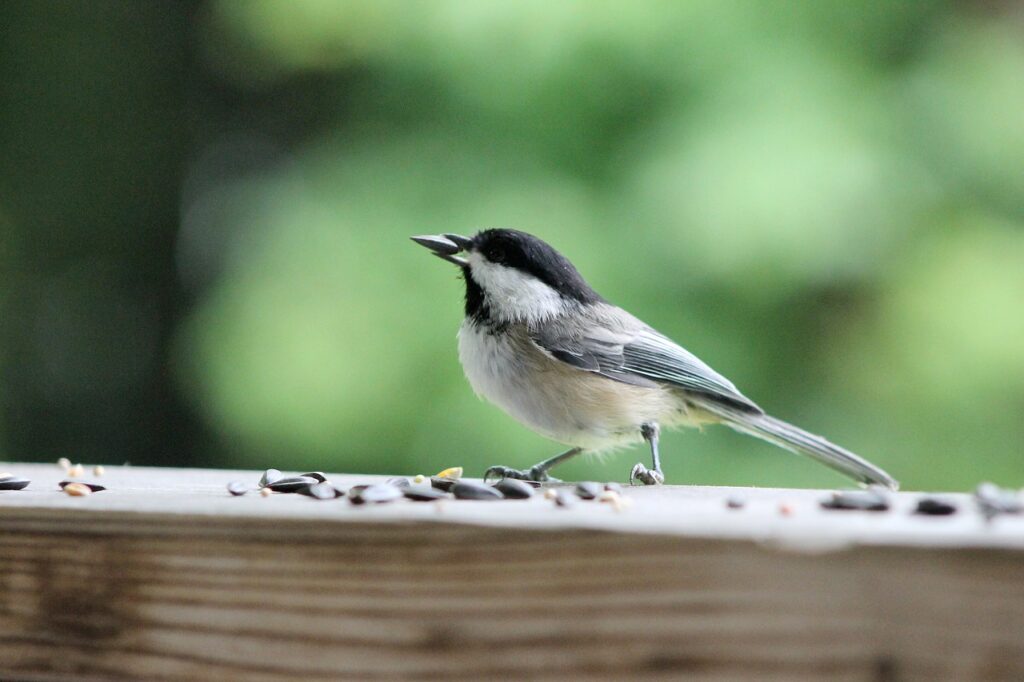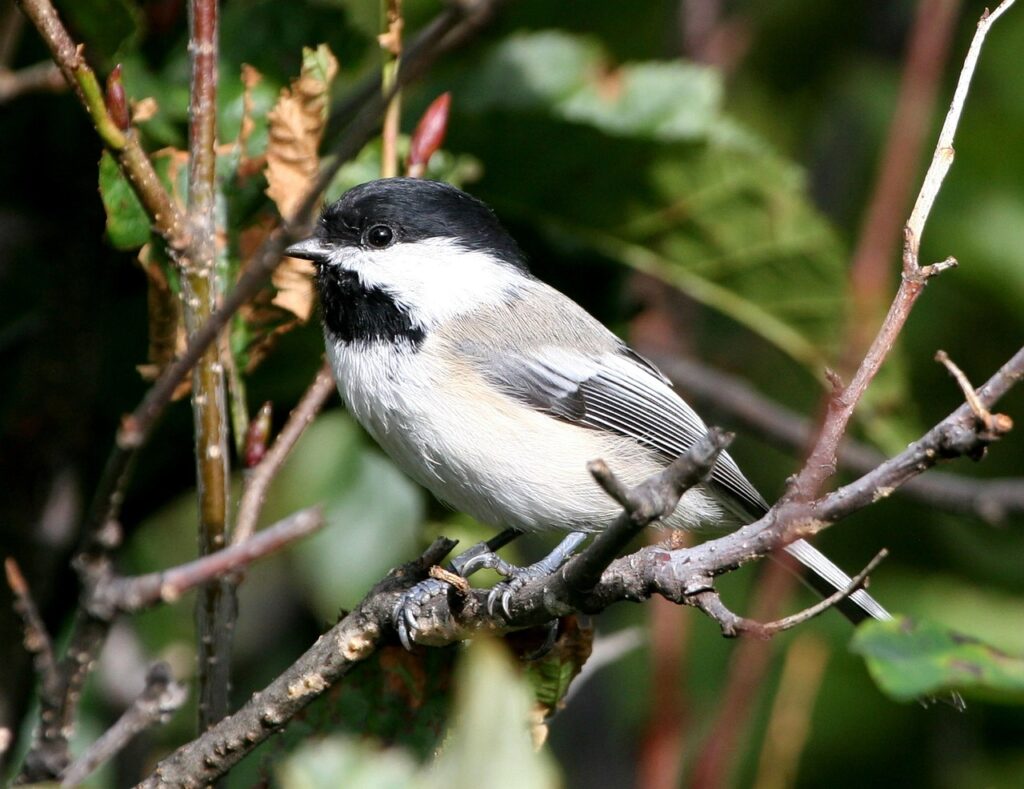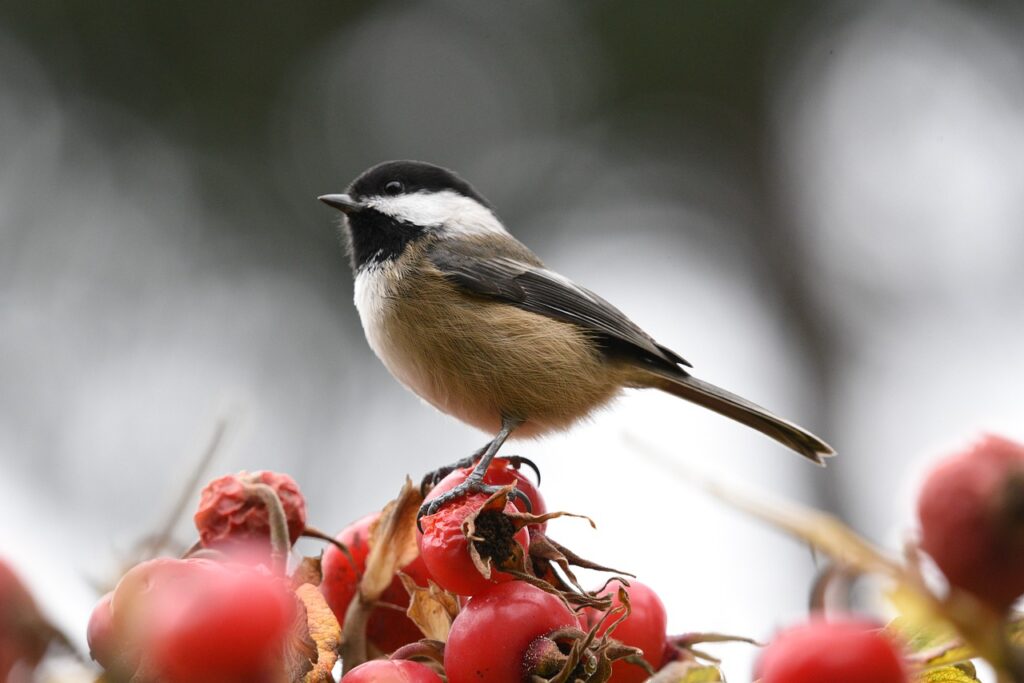If you put up a bird feeder, chances are that Black-Capped Chickadees will be the first to find it. This energetic bird is a familiar visitor to backyards across the upper-half of North America year-round.

Chickadees are remarkably tame. When I was a toddler, I walked right up to a Chickadee in the backyard and touched it. They can also be taught to eat bird seed straight from your hand if you’re patient enough!
Truth be told, if you hang up any bird feeder in their range, a Black-Capped Chickadee will likely appear. You don’t need special help for that. But, there are certain foods and things you can do to keep them coming back regularly.
These are my top tips below on bringing Chickadees to your yard.
Related Content: What’s the best bird seed? Read my comprehensive guide to bird feed
1. Attract Chickadees by Offering Sunflower Seed
Chickadees love both shelled and de-shelled sunflower seeds. They will gladly eat any cardinal seed blend you find. One of my favorite sights is seeing a Chickadee snag a sunflower seed, fly away and hide it in a nearby tree.
Beginners Tip: I recommend sunflower as your first bird seed purchase. It’s a crowd pleaser for Chickadees, Cardinals, Finches, Nuthatches and more
Sunflower chips, black oil sunflower and striped sunflower seeds all work really well at bringing in curious Chickadees. It’s more a matter of preference. I use sunflower chips to avoid any mess of seed hulls beneath and around my feeders.
Oh, and please look for quality sunflower bird seeds that’s free from fillers. Some red flags: Red milo, oats and wheat. This tip applies for any bird you’re looking to attract! The only birds who enjoy eating seed mixes with fillers are pest birds like Starlings and House Sparrows.
Related: The Best Bird Seeds on Amazon (Top 10 List)

2. Attract Chickadees with Mealworms
Mealworms are a secret weapon of mine to keep multiple Chickadees coming to my feeders ever day. They go wild for both live and dried mealworms. I’ve noticed that they love them so much that they often stay at the feeder to eat them right away. This is an amusing sight as the chickadee puts the worm between its feet and chows down.
I usually keep things simple and use these dried mealworms. They can be served in a separate tray feeder, or mixed into a seed blend for some added protein. Birds, especially Chickadees, love them. Live mealworms are even more successful at bringing in Bluebirds and other species.
Related Content: What Birds Eat Mealworms?
3. Put Your Feeder Near Trees and Brush
Chickadees aren’t particular about the type of feeder you put out. It’s much more important to consider where you put the feeder.
Chickadees like having a tree or bush nearby they can fly back and forth to. As previously mentioned, Chickadees prefer to snag a seed at feeders before flying away.
It’s helpful to put a feeder under or near any other natural cover you have so that the birds feel safer from predators when they visit.

4. Have a Water Source/Bird Bath
This tip applies to any bird you’re looking to attract to your yard and is especially important if you’re in a cold climate region in the winter. Most of the water freezes and consuming snow for water can cost birds a lot of precious energy and body heat.
Offer a bird bath with a heater, and your yard will quickly become a beacon for thirsty birds (including chicakdees!) who need a drink or bath.
Bonus: You can also invest in a bird bath water wiggler to create movement in your water source. This will attract the attention of even more birds with the noise and visual it creates! Here’s an example from my local Wild Bird Store.
5. Black-Capped Chickadees Go Nuts for Peanuts
Looking for one more thing to offer at your feeders? Start putting out peanuts (unsalted/unseasoned). Peanuts are a high-fat and protein-packed treat for birds. Chickadees like peanuts out of the shell. Their tiny beaks makes it difficult to break into large peanut shells.
Peanut also attract fun birds like the boisterous Blue Jay, Nuthatches and Woodpeckers. I have a bird feeder specifically for peanuts and have had great results…just watch out for squirrels.
Look for peanut pieces online, or at your local hardware or bird food store.
Related Content: The Definitive Bird Seed Power Rankings

Beyond the five tips above, I’ve also seen Chickadees eat suet (peanut-flavored especially), nyjer and safflower seeds. The beauty of Chickadees is that they’re curious birds and will be consistent guests at your home once you put out some of their favorite foods.
My current bird feeding set up consistently draws in a trio of chickadees daily to a mix of sunflower seed, peanuts and mealworms that I serve in a house-style hopper feeder.
I recommend this webpage by the Cornell Bird Lab if you’re curious about learning more about Chickadees.
Disclaimer: Some links found on this page are Amazon affiliate links. If you click an affiliate link and make a purchase, I might earn a commission. As an Amazon Associate I earn from qualifying purchases. (There’s no extra cost to you if you do this).

Pingback:A Comprehensive Guide to Attracting Minnesota Birds to Your Feeders - BIRD BITES
Pingback:The Definitive Bird Seed Power Rankings - BIRD BITES
Pingback:How to Attract 30+ Wisconsin Birds to Your Feeders (With Photos) - BIRD BITES
good information and also very useful,
Pingback:How to Attract 30+ Iowa Birds to Your Feeders - BIRD BITES
Pingback:How to Attract 30 North Dakota Birds to Your Feeders - BIRD BITES
Pingback:How to Attract 28 South Dakota Birds to Your Feeders - BIRD BITES
Pingback:How to Attract 30+ Michigan Birds to Your Feeders - BIRD BITES
Pingback:How to Attract 28 Indiana Birds to Your Feeders - BIRD BITES
Pingback:How to Attract 28 Ohio Birds to Your Feeders - BIRD BITES
Pingback:How to Attract 28 West Virginia Birds to Your Feeders - BIRD BITES
Pingback:How to Attract 28 New York Birds to Your Feeders - BIRD BITES
Pingback:How to Attract 27 Vermont Birds to Your Feeders - BIRD BITES
Pingback:How to Attract 21 New Hampshire Birds to Your Feeders in the Winter - BIRD BITES
Pingback:How to Attract 28 Illinois Birds to Your Feeders - BIRD BITES
Pingback:How to Attract 27 Missouri Birds to Your Feeders - BIRD BITES
Pingback:How to Attract 28 Rhode Island Birds to Your Feeders - BIRD BITES
Pingback:10 Birds That Like Eating Safflower Seed (With Photos) - BIRD BITES
Pingback:How to Attract 22 Connecticut Birds to Your Feeders in the Winter - BIRD BITES
Pingback:How to Attract 25 Maine Birds to Your Feeders - BIRD BITES
Pingback:How to Attract 28 New Jersey Birds to Your Feeders - BIRD BITES
Pingback:How to Attract 15 Alaska Birds to Your Feeders - BIRD BITES
Pingback:11 Birds That Like Eating Sunflower Seed (With Photos) - BIRD BITES
Pingback:How to Attract 27 Nebraska Birds to Your Feeders (With Photos) - BIRD BITES
Pingback:Ranking Bird Seed from Worst to Best - BIRD BITES
Pingback:How to Attract 29 Kansas Birds to Your Feeders (With Photos) - BIRD BITES
Pingback:How to Attract 28 Pennsylvania Birds to Your Feeders - BIRD BITES
Pingback:How to Attract 29 Virginia Birds to Your Feeders (With Photos) - BIRD BITES
Pingback:How to Attract 26 Montana Birds to Your Feeders - BIRD BITES